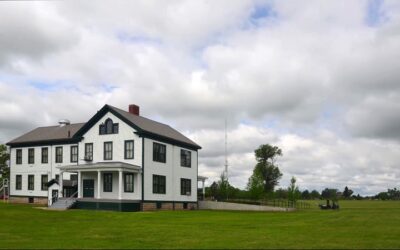Everything has a historical context, even the roads you drive on. Omaha’s Military Avenue has a history that stretches back to the 1847 Mormon road to Utah.

In 1857 it was a day’s journey from Omaha City to the Elkhorn River, and pioneer trails radiated outward from the frontier town. We’ve combined original survey maps with present-day streets to show where these early roads were. It’s part of a new Nebraska History article about the origins of Military Avenue. It really was a military road, and before that it was the “Mormon Road to Utah.”
Consider this 1857 survey map below. We’ve stitched together map images from the Nebraska State Surveyor’s Office, adding highlights and labels (in bold type) of selected features: 1857 roads in red; waterways in blue; present-day streets and highways in yellow.

This is a detail of the map that appears in Nebraska History, with present-day 144th Street on the left and the Missouri River on the right.
Where is Omaha? The boundaries of “Omaha City,” as it was then known, are marked to the right of the present North Freeway and I-480. It’s easier to see in this detail:

The neat grid of survey lines (in black) divide the land into quarter sections of 160 acres each. Four squares comprise a 640-acre section equal to a square mile. As you can see, many of today’s main thoroughfares follow those old section lines marked by the 1857 surveyors.
Those surveyors were thinking mostly in terms of land claims and farms, not roads. The few farms are marked with little cross-hatched boxes. Most of the land was prairie. Omaha, in the earliest known photo of the city, looked like this:

The view here is from a road leading into town from the south. The Missouri River is in the background, and the large building at right is the Herndon House, an early hotel built in 1858 at Ninth and Farnam. (photo number: RG2341-3-a)
As for roads, they followed the lay of the land, and aimed for spots where it was easiest to ford the creeks. No bridges were yet built.
Look at the big map again. See that place where Dodge Street jogs north and becomes West Dodge Road? It does so at the spot where the old Road from Omaha to Elk Horn City (today’s Elk City, not Elkhorn) used to cross the Little Papio. By the time Dodge was graded west from the creek, it was easier to follow the section line.
And Military Avenue? For much of its route, it follows the old “Mormon Road to Utah,” which dates to 1847. The US Army later improved the trail and built bridges to better supply Fort Kearny—that’s why people started calling it “Military Road.” Below is another section of the highlighted 1857 map, indicating 144th Street on the right and Highway 31 in the center. Notice how today’s Military Avenue follows the old Mormon Road to Utah through west Omaha. “Elk Horn City” is present-day Elk City, not Elkhorn (which wasn’t founded yet). Near Elk Horn City was a ferry across the Elkhorn River.

All this is told (with more maps and photos) in “Over Hill, Over Dale: A Nineteenth Century Biography of Omaha’s Military Road Network,” by Jo Wetherilt Behrens (of University of Nebraska-Omaha) in the Fall 2018 issue of Nebraska History.
History Nebraska members receive Nebraska History; individual copies are available via the Nebraska History Museum.
—David L. Bristow, Editor




